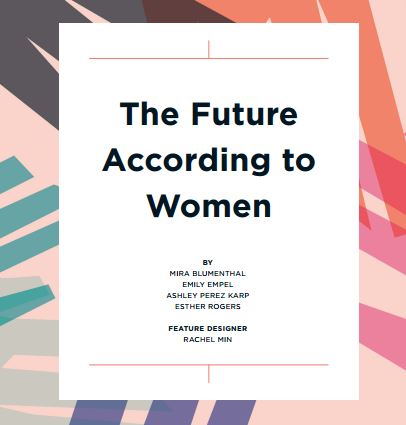
Usually I select small snips for your Friday assignment: videos that are less than 10 minutes long; short reads; sometimes just a mind-blowing picture. This week I’m strongly recommending a long read as well worth your while: The Future According to Women, a special issue of MISC Magazine. (Available as a free download.) I mentioned this volume when it first came out last month, but I just finished the reading the closing essay, and that inspired me to nudge you again it its direction.
This week I’m strongly recommending a long read as well worth your while: The Future According to Women, a special issue of MISC Magazine. (Available as a free download.) I mentioned this volume when it first came out last month, but I just finished the reading the closing essay, and that inspired me to nudge you again it its direction.
This project was spawned by a sense of frustration in the futurist community about the image of our field as largely male. As the editors note in the introduction, “the future we read about is made up of recycled bits of interviews curated from the minds of a few great men innovating in Silicon Valley.”
To counter this perception, the editors compiled this collection of extended essays, short fiction and brief interviews by and with over forty women young and old–futurists, writers, scholars, scientists, entrepreneurs and students. They address topics that might be considered stereotypically female, such as child-rearing, relationships, PMS and girlhood, but also encompass war, space exploration, law, labor, gender identity and global sustainability.
I admit that when I first heard about the project, I was skeptical that foresight is gendered. Do women approach thinking about the world in general, and the future specifically, differently than men? However, after reading the collection, I think it is sometimes true. For example, Dr. Gillian Einstein notes, in an essay on the future of women’s health, that our biomedical systems revolve around diagnosis and treatment of acute conditions such as heart attacks. But, she notes, as we become better at keeping people from dying right away from heart disease or cancer, they turn into chronic conditions, and “women tend to bear the burden of chronic disease.” (She lists heart conditions in old age, fibromyalgia, chronic pain and autoimmune disorders as examples). By shifting focus to these chronic conditions in women, she hopes we will reshape our healthcare system, broadening its focus from immediate heroics to give proper attention to long-term care.
Whether or not the ideas presented in these essays are influenced by the chromosomal makeup of the authors, I agree with the editors that it is important to demonstrate that the future is not solely the provenance of (old, white) men.
And as a bonus, scattered through out the issue are mentions of truly mind-blowing organizations of which I was unaware, such as the Modern Widows Club (a “widow mentoring organization), Make Love Not Porn (“pro-sex, pro-porn and pro-knowing the difference), and Manservants (which promises to match any lady with the manservant of her dreams. Check out their promotional video).
In a closing note, the editors declare: “We have the ability to democratize the future that we see, hear and read about. Conversations can, and should, include more women as well as other untapped perspectives that exist outside of Silicon Valley, Hollywood or the field of professional foresight.” Nor, I would add, should our vision of the future be exclusively white, Western, and fostered in a climate of economic privilege. You, as museum people, can contribute to our collective futuring, and encourage people in the communities you serve to do so as well.
The MISC website hosts additional interviews related to the project on the web (including one with me, on the future of museums, ‘natch). You can also follow the continued conversation on social media where it is tagged #femalefutures.
Enjoy!








